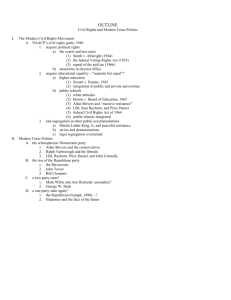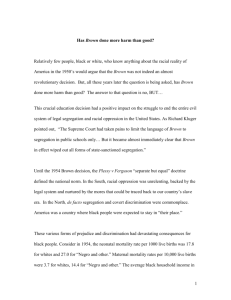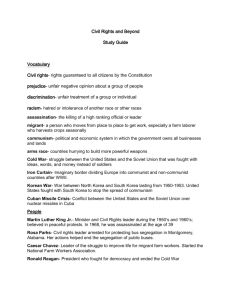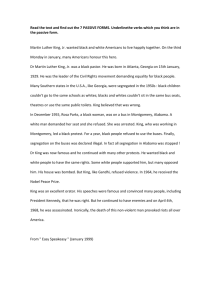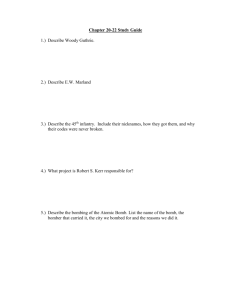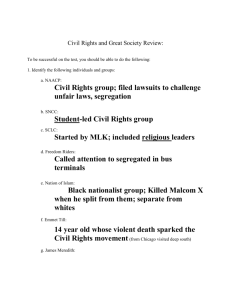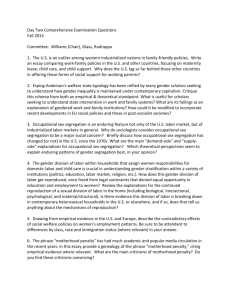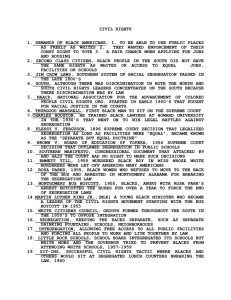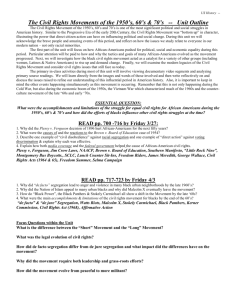CIVIL RIGHTS
advertisement
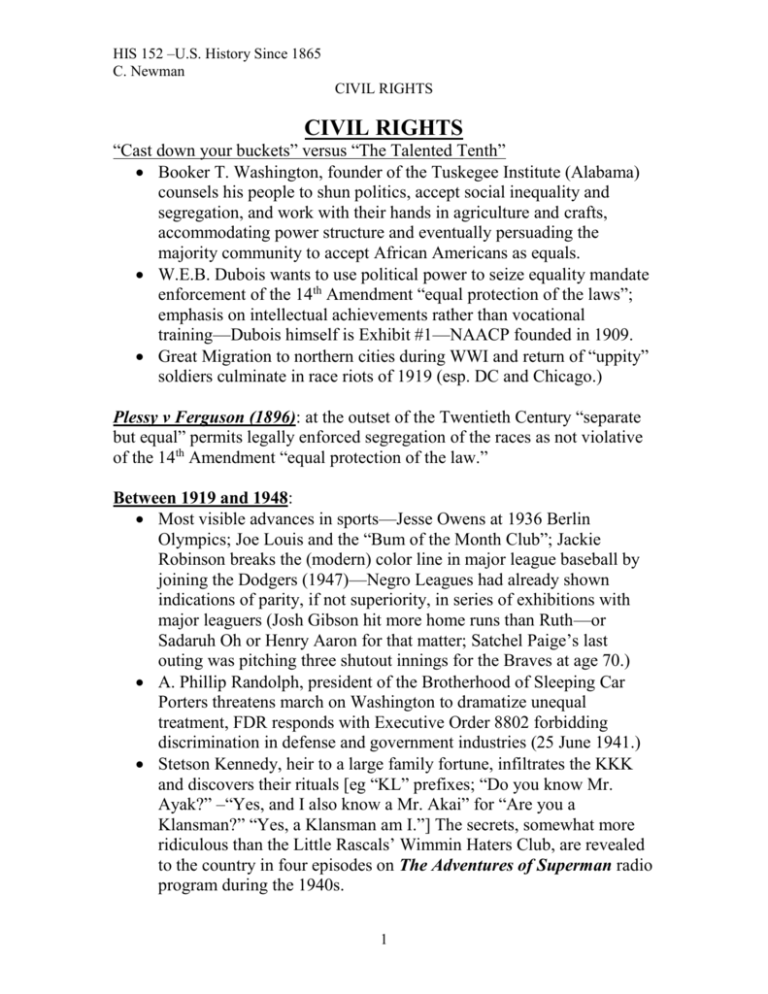
HIS 152 –U.S. History Since 1865 C. Newman CIVIL RIGHTS CIVIL RIGHTS “Cast down your buckets” versus “The Talented Tenth” Booker T. Washington, founder of the Tuskegee Institute (Alabama) counsels his people to shun politics, accept social inequality and segregation, and work with their hands in agriculture and crafts, accommodating power structure and eventually persuading the majority community to accept African Americans as equals. W.E.B. Dubois wants to use political power to seize equality mandate enforcement of the 14th Amendment “equal protection of the laws”; emphasis on intellectual achievements rather than vocational training—Dubois himself is Exhibit #1—NAACP founded in 1909. Great Migration to northern cities during WWI and return of “uppity” soldiers culminate in race riots of 1919 (esp. DC and Chicago.) Plessy v Ferguson (1896): at the outset of the Twentieth Century “separate but equal” permits legally enforced segregation of the races as not violative of the 14th Amendment “equal protection of the law.” Between 1919 and 1948: Most visible advances in sports—Jesse Owens at 1936 Berlin Olympics; Joe Louis and the “Bum of the Month Club”; Jackie Robinson breaks the (modern) color line in major league baseball by joining the Dodgers (1947)—Negro Leagues had already shown indications of parity, if not superiority, in series of exhibitions with major leaguers (Josh Gibson hit more home runs than Ruth—or Sadaruh Oh or Henry Aaron for that matter; Satchel Paige’s last outing was pitching three shutout innings for the Braves at age 70.) A. Phillip Randolph, president of the Brotherhood of Sleeping Car Porters threatens march on Washington to dramatize unequal treatment, FDR responds with Executive Order 8802 forbidding discrimination in defense and government industries (25 June 1941.) Stetson Kennedy, heir to a large family fortune, infiltrates the KKK and discovers their rituals [eg “KL” prefixes; “Do you know Mr. Ayak?” –“Yes, and I also know a Mr. Akai” for “Are you a Klansman?” “Yes, a Klansman am I.”] The secrets, somewhat more ridiculous than the Little Rascals’ Wimmin Haters Club, are revealed to the country in four episodes on The Adventures of Superman radio program during the 1940s. 1 HIS 152 –U.S. History Since 1865 C. Newman CIVIL RIGHTS Smith v Allwright (1944) declares unconstitutional the all-white primary, by which Southern whites had controlled the Democratic Party for generations. Shelley v Kramer (1948) declares restrictive covenant in deeds to be unenforceable. Truman creates his Committee on Civil Rights (1946) which produces proposals to “implement the Bill of Rights in fact”—conservativedominated Congress rejects the proposed legislation. Truman ends segregation in the military by proclamation (26 April 1948) and requires fair employment by government contractors by executive order the same day. Brown v Board of Education of Topeka, KS (17 May 1954) declares that separate is inherently unequal and thus segregation is unconstitutional— overruling Plessy; segregation to be accomplished “with all deliberate speed.” August, 1955: Emmett Till, 14 years old, lynched in Mississippi. December 5, 1955: Montgomery, AL bus boycott begins when Rosa Parks is arrested for failing to give her seat to a white man—boycott ends when bus company surrenders and ends segregated buses 21 December 1956. Southern Christian Leadership Conference formed Jan. 1957, with Martin Luther King Jr. at its head. Civil Rights Act of 1957 strengthens voting rights through individual suits for enforcement, creates National Commission on Civil Rights. Sept. 1957 brings crisis at Central High in Little Rock as whites riot to prevent desegregation—Ike sends in federal troops to integrate per federal court order. Sit-ins at eating facilities in variety stores (primarily Woolworth’s) begin in Greensboro, NC (1 Feb. 1960); Student Nonviolent Coordinating Committee (SNCC) formed in April. CORE’s (Congress on Racial Equality) Freedom Rides, where blacks and whites ride together on buses through the South and integrate White and Colored facilities in local bus stations, are met with redneck violence organized by local law enforcement (May-Nov., 1961) with ICC banning segregation in interstate busing terminals. 2 HIS 152 –U.S. History Since 1865 C. Newman CIVIL RIGHTS Voter Education Project (begun April, 1962) attempts to register African American voters in the South with the blessing of Attorney General RFK (he wrongly thinks that this is a non-controversial issue—many civil rights workers are killed, esp. the “Mississippi Burning” killings of James Chaney, Andrew Goodman, and Michael Schwerner by Klansmen and the Sheriff’s Department of Meridian, Mississippi (21 June 1964.) The March on Washington (28 August 1963) with Mahalia’s “Move on Up a Little Higher” and King’s “I Have a Dream” speech. Four little girls are killed when racists dynamite a church in Birmingham, AL (15 September 1963.) Malcolm X and Elijah Muhammed preach separation and black supremacy—Malcolm splits to become a Sunni, preaching selfreliance; assassinated in DC by Black Muslims (1965). Long hot summers when cities burn: Harlem—July, 1964; Watts— August 11-16, 1965; Cleveland and Chicago—(1966); Newark and Detroit—1967; King killed in Memphis 4 April 1968 and nearly everything burns. LBJ engineers Civil Rights Act of 1964, which outlaws segregation in restaurants, theaters and public lodging (upheld as an extension of the commerce clause in Heart of Atlanta Motel v US (1964). LBJ also engineers Voting Rights Act of 1965, which places conduct of voter registration and voting in the hands of federal authorities in the event of local misconduct. 3

